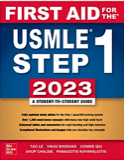The Picmonic founders were right: medical students are craving a more engaging and interesting way to memorize and learn the hundreds of thousands of facts necessary to become a doctor. As we all know, the journey to becoming a medical professional is not an easy one. We’ve gathered valuable insights and advice from REAL medical students on their experience and tips that helped them through their medical school journey.
Tips for Med Students from Med Students
Use the First-Aid USMLE Book

The First Aid for the USMLE Step 1 book is basically like the bible for medical students. Every med student in the country comes to a defining moment in their education when they bury their heads in this holy book, desperate to absorb pages and pages and pages of information in preparation for the mother of all exams: USMLE. The battle to perform well on the boards, and every subsequent shelf exam is a shared experience between all med students, and having the right resources really helps.
Focus on Retention, not Memorization
Many students spend countless hours studying daunting lists of information, memorizing more syllables in one word than thought linguistically possible, and days upon days of mindless repetition. Even for the students who are able to conquer the exam, their efforts rarely equal their retention. Many students report the same depressing conclusion: no matter the time spent studying and memorizing, the information didn’t really stick after the exam. Incorporating retention focused tools like Picmonic into study sessions can be a game changer for students seeking effective and lasting outcomes. By utilizing mnemonic techniques, learning aids and engaging story telling, platforms such as Picmonic not only enhance comprehension, but also significantly improve the retention of complex medical information.
Study Using Mnemonics with Vivid Imagery

Using mnemonics with vivid imagery is highly effective in enhancing memory and learning because it taps into the brain’s natural ability to retain visual information. Here’s memory champion and mental athlete, Joshua Foer’s take on the topic:
“The more vivid the image, the more likely it is to cleave to its locus. What distinguishes a great mnemonist…is the ability to create these sorts of lavish images on the fly, to paint in the mind a scene so unlike any that has been seen before that it cannot be forgotten”
Needless to say, there are more than a few memorably outrageous images that comprise over 300 audio-visual mnemonics for high-yield medical topics in the Picmonic collection.
Gamify your studying
Believe it or not, a lot of med students are quite creative. They enjoy gamifying their studying using images and other clever ways to incorporate information into their minds.
Here are some other suggestions from med students that help to gamify their learning:
- Create a quiz after each topic you study to test your knowledge
- Use the Picmonic mobile app for on the go learning and draw your own images on the Picmonic cards and create your own summary of the mnemonic characters
- Use stickers and tags on your notes and textbooks
- Create a flashcards for quick review of information
This advice shared by real medical students offer a roadmap for aspiring doctors to not only survive, but instead thrive in the journey through medical school. By heeding their wisdom, you can navigate the rigors of medical school with confidence.













